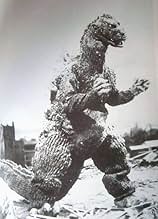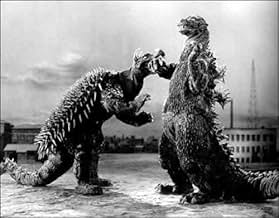NOTE IMDb
5,7/10
9,1 k
MA NOTE
Ajouter une intrigue dans votre langueScout pilots for a fishing company are startled to discover a second Godzilla, whose battle with rival monster Anguirus threatens to destroy Osaka.Scout pilots for a fishing company are startled to discover a second Godzilla, whose battle with rival monster Anguirus threatens to destroy Osaka.Scout pilots for a fishing company are startled to discover a second Godzilla, whose battle with rival monster Anguirus threatens to destroy Osaka.
- Réalisation
- Scénario
- Casting principal
- Récompenses
- 1 nomination au total
Shirô Tsuchiya
- Captain of Fishing Boat
- (as Hirotoshi Tsuchiya)
Avis à la une
I finally now have seen this the second Godzilla movie made. The first where Godzilla takes on another monster...the other monster presented is Anguirus. The story was pretty good for the most part as they make it clear in the Japanese cut anyway, that this is a new Godzilla and not the one destroyed by the oxygen destroyer. Also, this new monster is also discovered. The cities just off the coast are on alert, everything seems to go well until a bunch of prisoners escape and start a large fire (light apparently attracts Godzilla)and not only does he come, but so does Anguirus and they battle in the city. After the battle there is time to relax as Godzilla leaves peaceful like enough and the city was evacuated very well this time too. Everything is going well until Godzilla reappears in a more northern town, however at one point he is in the middle of a bunch of snow capped mountains and a plan is hatched to stop Godzilla's onslaught again. This movie could have been better though, there is a lot of filler in this movie, I am thinking they felt they needed more scenes to pad out a rather short running time film. However, with this movie coming out only six months after the original, the extra scenes had to be scenes of people rather than of the monsters. Also, the film goes on a bit to long well after the battle between the two monsters. So much so that the threat of Godzilla seems to even evaporate for a time. I also think the plane scene at the end went on to long as their plan should have to worked after they figured it out rather than going back to base to load up on missiles. However, the fight between the two monsters is rather good, and unlike the professional wrestling like quality of the next movie "Godzilla vs King Kong" in this one the monsters fighting seems to be like that of two actual animals and not men in costumes. I think this one would have been much better though if they did not rush to complete it.
The Two pilots Kobayashi and Tsukioka must land on a remote Pacific Island and become witnesses of the fight between two giant monsters. After the battle, they both disappear into the ocean. Tsukioka informs scientists (including Dr. Yamane from the first "Godzilla" film) and the army about Godzilla and an unknown monster that looks like a prehistoric Ankylosaurus. The new monster therefor is named Angilas. Meanwhile, some bandits escape near Osaka and cause a car crash that is followed by large explosions. The fire attracts Godzilla to Osaka. The Japanese army tries to stop the monster using tanks, missiles and the air force. Then Angilas shows up too! The two monsters fight each other in the middle of the city in a brutal battle which is won by Godzilla. In order to stop him, the Osaka Defense Corps (and the two friends Kobayashi and Tsukioka) follow Godzilla to a snowy island near Hokkaido in northern Japan. Many pilots die in the final battle against the monster, as the army tries to cause an avalanche to bury Godzilla...
This is the little-known second film of the legendary Japanese Godzilla series, and the last that was filmed in black & white. It lacks, of course, most of the metaphoric meaning the first film had and is just a very entertaining, classic monster movie. The beautiful music score was composed by Masaru Satô, the favourite composer of Akira Kurosawa. It sounds a bit like a softer version of Akira Ifukube's great theme music for the first film. Like in the first "Godzilla", the black & white photography adds to the plausibility of the special effects, therefor they work really good most of the time. Probably the biggest problem with the effects is that the monsters move by far too fast in their fight scenes. But fortunately "Gojira no gyakushû" was the only Japanese monster movie ever to use this technique. Please note that this commentary is based on the original, uncut Japanese version of the film which really is the ONLY way to see it!! The American version is badly dubbed, has half of the movie cut out, inserts new scenes that don't make ANY sense, and has special effects footage stolen from other movies... it's just total crap. Everybody who is interested in seeing this film should look for the Japanese version, it's definitely worth the effort. Unfortunately, it is probably very hard to find. Despite the success of the film in Japan, the next "Godzilla" movie was not made for seven years.
This is the little-known second film of the legendary Japanese Godzilla series, and the last that was filmed in black & white. It lacks, of course, most of the metaphoric meaning the first film had and is just a very entertaining, classic monster movie. The beautiful music score was composed by Masaru Satô, the favourite composer of Akira Kurosawa. It sounds a bit like a softer version of Akira Ifukube's great theme music for the first film. Like in the first "Godzilla", the black & white photography adds to the plausibility of the special effects, therefor they work really good most of the time. Probably the biggest problem with the effects is that the monsters move by far too fast in their fight scenes. But fortunately "Gojira no gyakushû" was the only Japanese monster movie ever to use this technique. Please note that this commentary is based on the original, uncut Japanese version of the film which really is the ONLY way to see it!! The American version is badly dubbed, has half of the movie cut out, inserts new scenes that don't make ANY sense, and has special effects footage stolen from other movies... it's just total crap. Everybody who is interested in seeing this film should look for the Japanese version, it's definitely worth the effort. Unfortunately, it is probably very hard to find. Despite the success of the film in Japan, the next "Godzilla" movie was not made for seven years.
Picked up the remastered version recently released. It has the Japanese and American versions of the film. I watched the longer Japanese version which is oh so much better. Gone is the stupid narration. The voices actually match the characters and don't come off dopey. There are also scenes with silences, something the American version seemed afraid to have. I used to think this was a dull and boring film, but it actually held my attention this time out, even when my brother was kibitzing to get me to go shopping with him. If you like these sort of movies and get the chance watch this in Japanese and see it for the first time. (FYI- the new remasters do not allow toggling between versions because the Japanese versions are usually longer, even by a minute or two than the Americans so you can only see the differences by watching the versions back to back.)
Another of Godzilla's species is discovered on an island, along with a spiky creature called Angilusaurus (or Angilus for short). Before long the two monsters are wrecking havoc.
Though this film was rushed out, it has the advantages of being made in the age when Godzilla films were serious-themed. The scenes in which city populations are told to turn their lights off to avoid Godzilla's attention at night are atmospheric and recall World War 2, when city lights were turned off to avoid the attention of enemy bombers. The music is haunting and the scenery, especially on the island, is suitably eerie. The film does tail away towards the end, but it's still one of the stronger sequels.
As with the original, and most other Godzilla films, the original non-dubbed version with subtitles is recommended.
Though this film was rushed out, it has the advantages of being made in the age when Godzilla films were serious-themed. The scenes in which city populations are told to turn their lights off to avoid Godzilla's attention at night are atmospheric and recall World War 2, when city lights were turned off to avoid the attention of enemy bombers. The music is haunting and the scenery, especially on the island, is suitably eerie. The film does tail away towards the end, but it's still one of the stronger sequels.
As with the original, and most other Godzilla films, the original non-dubbed version with subtitles is recommended.
Not the overpowering mandate against technological advances that Gozilla was, but nonetheless a good sequel that treats the Godzilla story reverently with realistic horrors of destruction, subtle humour, and interesting characters. The movie has some pockets of slow moving action, but the finale is a beautifully filmed scene of the creature being thwarted on an island of mountains and ice. The film has a Godzilla with a different look as well as another creature with a spiked back that destroy Osaka together. Characterization, as with the first Godzilla, lends the film some seriousness and realism. The destruction scenes in particular are nicely filmed, as they show a city in fear...and then destroyed. The film lacks Inshiro Hondo's directorial flair, but is well-shot and has a nice musical score to enhance it.
Le saviez-vous
- AnecdotesSpecial effects director Eiji Tsuburaya wanted the battle between Godzilla and Anguirus filmed in slow motion, but a camera technician accidentally undercranked the camera instead of overcranking it, resulting in the movement appearing faster than reality. Tsuburaya thought it looked interesting and decided to use it in the film anyway.
- GaffesIn the film when Osaka's blackout is put into effect, all of the lights in the city turn off, including car lights.
- Citations
[last line; Japanese version]
Shoichi Tsukioka: Kobayashi... we beat Godzilla for you.
- Versions alternativesIn the U.S. version of the film, the scene where the film of Godzilla's first attack on Tokyo is shown has several seconds added on to it as well as stop-motion footage provided by Warner Bros. Also, the film adds narration to the sequence.
- ConnexionsEdited from Godzilla (1954)
Meilleurs choix
Connectez-vous pour évaluer et suivre la liste de favoris afin de recevoir des recommandations personnalisées
- How long is Godzilla Raids Again?Alimenté par Alexa
Détails
- Date de sortie
- Pays d’origine
- Langue
- Aussi connu sous le nom de
- Godzilla Raids Again
- Société de production
- Voir plus de crédits d'entreprise sur IMDbPro
Box-office
- Budget
- 800 000 $US (estimé)
- Montant brut mondial
- 236 $US
- Durée1 heure 22 minutes
- Couleur
- Rapport de forme
- 1.37 : 1
Contribuer à cette page
Suggérer une modification ou ajouter du contenu manquant



























